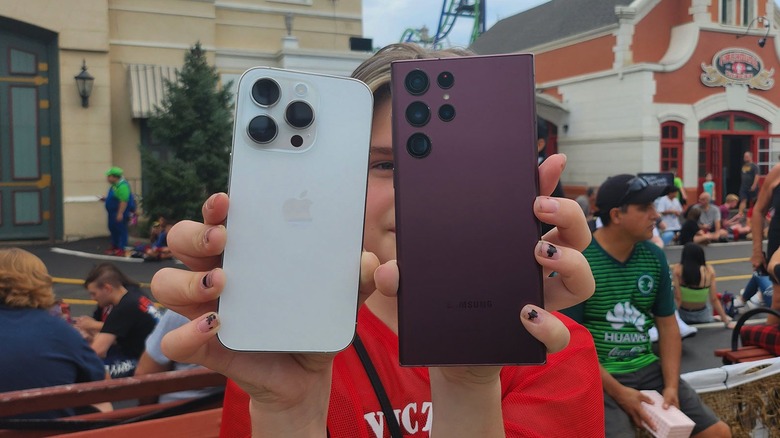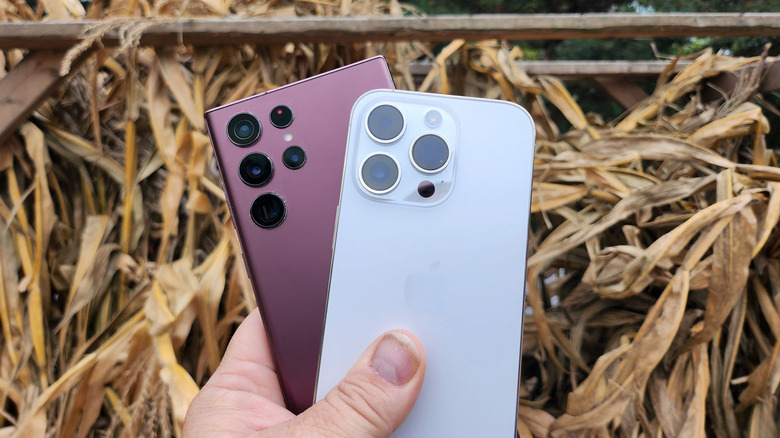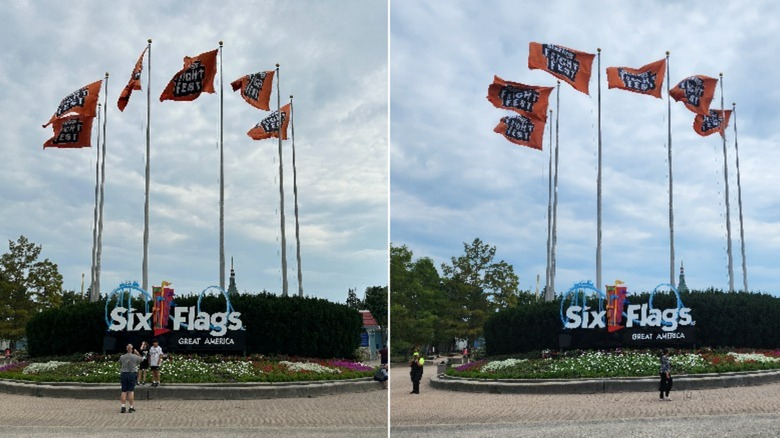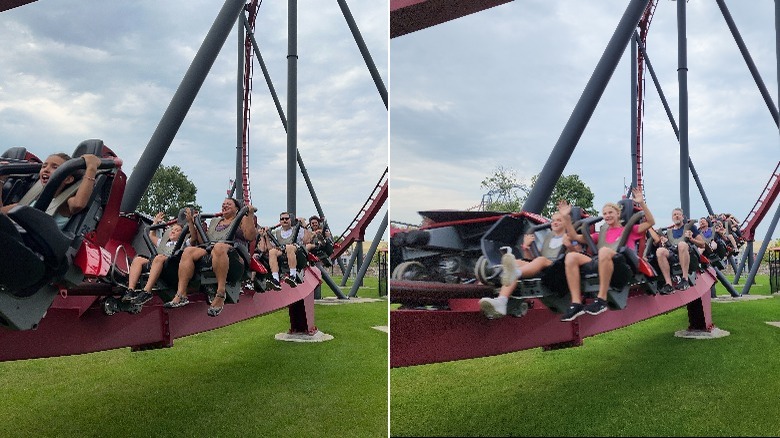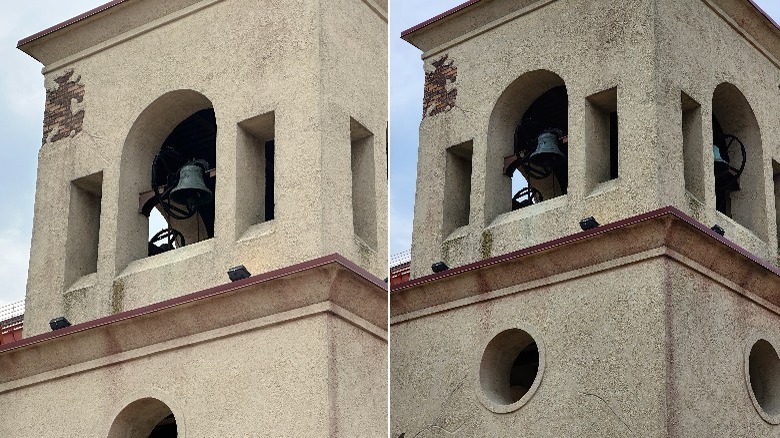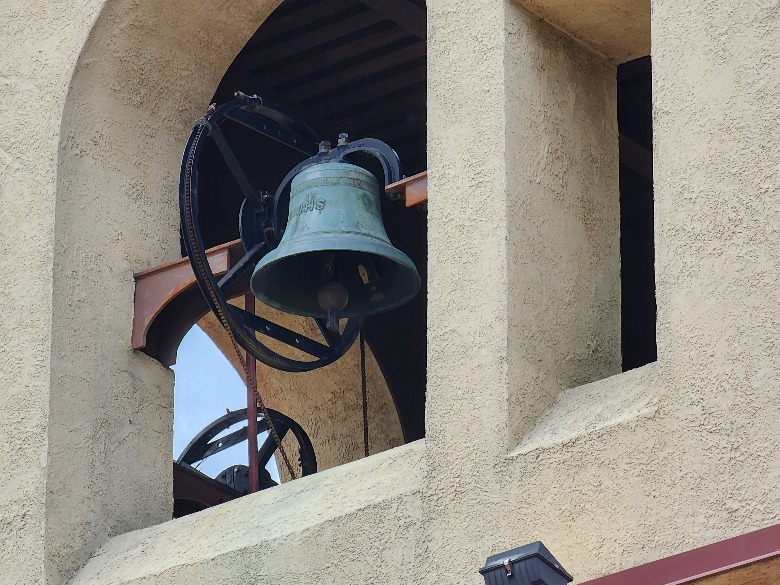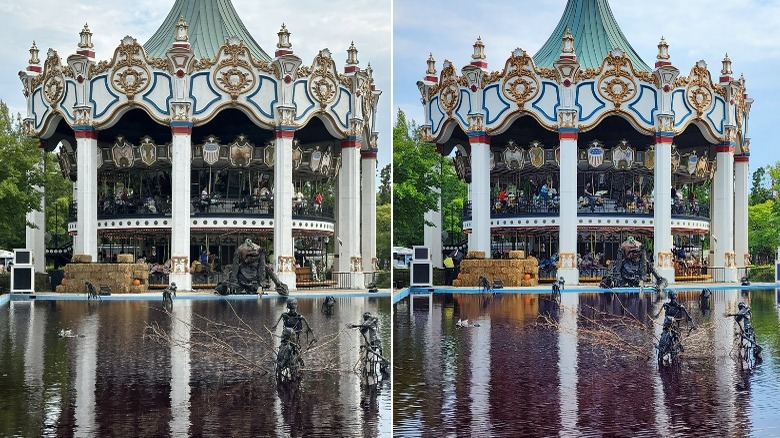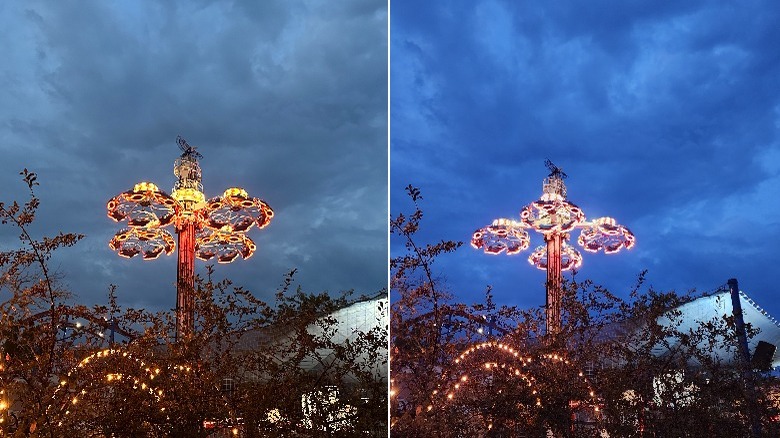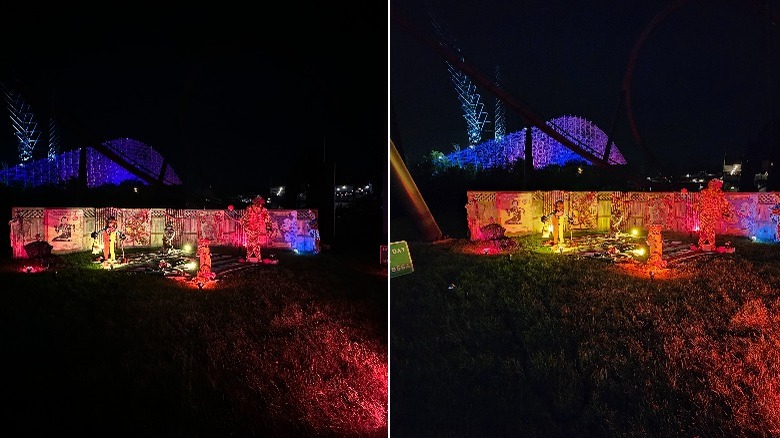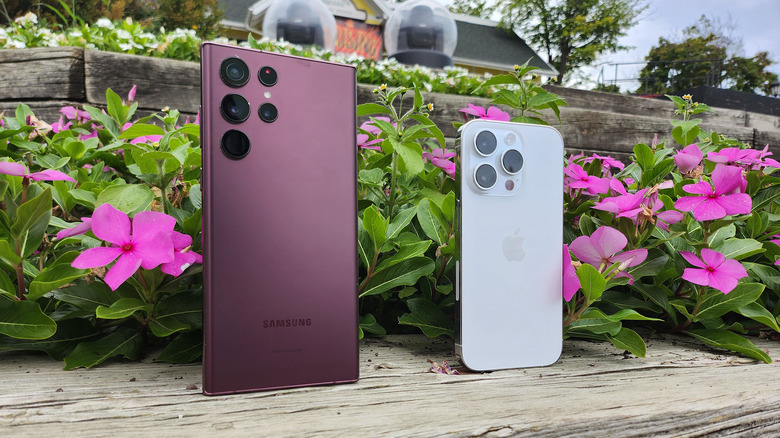iPhone 14 Pro Vs Samsung Galaxy S22 Ultra Camera Shootout: Battle Of The Best
If you live in the U.S., there are two top-tier flagship phones in the conversation. There's the Samsung Galaxy S22 Ultra and the iPhone 14 Pro. Both of these phones are absolute beasts when it comes to providing a complete computing experience in your pocket on the go. They both appear to offer the best of everything — the best processor, the best RAM, the best battery, there are no corners cut on either of these phones.
But there's one area where the two of them take similar, but distinct paths — the camera system. Both of these phones have impressive camera setups, but one of them clearly stands over the other in one particular area, while the other is miles ahead in another category. Beyond these divergences, it's hard to tell which is decisively better. But I needed an answer, so I spent a day in a theme park that was just waking up to Halloween season, both devices in hand.
Check out the hardware
As always, we'll start with a look at the spec sheet. Both of these phones have a typical three-camera setup in the main sensor, ultrawide, and telephoto lenses. What's different is basically everything else starting with the fact that Samsung adds on a fourth camera lens for an even more powerful telephoto option. Meanwhile, the iPhone 14 Pro is rocking a brand-new sensor this year.
The new camera hardware the iPhone 14 Pro is using is a 48-megapixel shooter with f/1.8 aperture and 1.22-micron pixels. The telephoto and wide-angle lenses are the same as last year. They're both 12-megapixel shooters. The telephoto lens has an f/2.8 aperture and 3X optical zoom while the ultrawide sensor has an f/2.2 aperture with a 120-degree field of view.
Samsung's main camera hardware is a 108-megapixel sensor with f/1.8 aperture and 0.8-micron pixels. Both telephoto lenses are 10-megapixel shooters. The 10x optical zoom sensor has an f/4.9 aperture while the 3X zoom sensor has an aperture of f/2.4. Finally, there's a 12-megapixel ultrawide sensor with a 120-degree field of view.
So, here's how they stack up against each other. In the photos below, the left will be the iPhone photo and the right will be the Samsung photo.
When the sun shines, so do the main cameras
The first thing you'll notice in most of these photos is that Samsung's cameras are a bit more colorful and poppy due to Samsung's photo processing. This has been Samsung's M.O. for years now. The orange flags and "Six Flags" sign are where these really stand out. Either image is perfectly fine for sharing, but Samsung's pops just a bit more.
But the iPhone image is a bit sharper, and this is again noticed particularly in the flags which were waving at a good clip when I shot both of these photos. The difference is a little subtle and barely noticeable when sent through the algorithmic trash compactor that is social media. It only becomes really apparent at a 100% crop like these two photos below.
The iPhone seems to use a faster shutter speed which is going to result in a bit of a darker photo, that is also a lot sharper with moving subjects. That was apparent throughout all the shots I took. Samsung prefers brighter colors and knows that most of its shots will be reduced to Facebook or Instagram so it's a very fair trade off.
Taking it all in, ultrawide style
Both phones capture ultrawide photos with 120-degree fields of view and just like with the main lens, Samsung spruces up the photo with extra processing to make things "prettier." That's prettier as determined by Samsung that is. The iPhone 14 pro meanwhile takes the same conservative approach.
In terms of color consistency between the ultrawide and main lens, it's pretty close to a tie. The reason there's a color difference is because of the combined factors of sensor size and aperture. It's not unusual to see darker colors from the ultrawide lens, but in this case, both phones keep a good accurate color palette between the lenses, but I'll give an edge here to Apple.
Samsung still applies aggressive color processing resulting in photos that pop more. Samsung also does a little better on the edges straightening up the fisheye effect. Apple could stand to apply a bit more processing to subjects in the foreground, as evidenced by the 100% crops below.
The skin and clothing of this woman in the foreground are a pixelated mess on the iPhone capture while Samsung handles it all much more smoothly. That's the only area where the iPhone fell short — everything else is clear and smooth.
Bursting with action!
Burst mode on both phones results in solid shots with a lot of detail, but I have to give the nod to the iPhone 14 Pro. The burst shots it produced are sharper from front to back of the roller coaster car while the Samsung Galaxy S22 had a much narrower depth of field. The iPhone 14 Pro exhibited more grain at 100% resolution, while the S22 was much better at smoothing those patchy areas.
Neither camera is limited to a specific number of burst shots, though neither phone starts a burst capture by holding down the shutter button (like they should). Rather, you have to press, hold, and slide the camera button. I'd argue that in a situation where you'd want to take a burst photo, you won't want to have to think about which way you need to slide your finger, but what do I know? Regardless, it takes a practiced hand to capture burst shots, so you'll want to be sure to practice if you're planning on using either device.
Zooming In optically
This is the section of this article that seems so unfair, I shouldn't even write it. For purposes of this section on zoom, we're sticking with optical zoom. There will be more ... and a bit of a rant ... on digital zoom in the next section. The iPhone is equipped with a 3x optical zoom lens while the Samsung Galaxy S22 Ultra has both 3x and 10x optical zoom on board.
It's really no contest here; 10x optical zoom is simply better in any number of different applications. From scenery to school recitals, to sports photography, the closer you can get to your subject, the better. Put simply, in the 3x image above (on the left), the iPhone 14 Pro will tell you there's a bell in the tower. The Galaxy s22 Ultra's 10x zoom (below) will let you count the rivets in it.
In all fairness, I need to point out that the 10x optical zoom of the Galaxy S22 Ultra comes as part of a package that is $200 more than the base model iPhone 14 Pro. Is 10x optical zoom worth $200? That's something that everyone has to answer for themselves — either yes or wrong. I'm kidding, but in my world, 10x is the solution to a problem that phone cameras have had for years.
The zoom no one asked for
Apple's spanking-new 48-megapixel sensor means that it can join in on the "digital zoom" party by cropping a full res photo. That's nice. But phones have been doing this for years, and the Samsung Galaxy S22 Ultra does it as well, so I took a few shots at 2x to compare. In all fairness, I prefer the iPhone's version of the digital crop. Samsung over-sharpens its digital crops so the ripples in the water above are shadows of their former selves. Apple takes a much more conservative approach and frankly, its photos are better for it.
But the fact is, that only the Pro models of iPhone have both 3x optical zoom and 48-megapixel sensors that allow for a digital crop which makes one of them redundant. I would much rather see an iPhone 14 Pro use a 2x digital crop and a 5x optical zoom sensor. That would make a lot more sense given the difference in magnification. Few people have ever tried to frame up a 3x optical zoom shot and thought to themselves, "gosh, I wish I could step this back to 2x." Those same people would just take the photo at 1x and guess what they'd do. They'd crop it into where they wanted it.
When it comes to zoom, Samsung innovated, and Apple took the easy way out. With that, my soapbox rant is over.
Lights, Camera, Action!
However, the good news for Apple is that if the Galaxy S22 Ultra steals the iPhone 14 Pro's lunch money on zoom, Apple steals it right back on the video front, including its new feature "Action mode." Action mode allows you to run, skip, and jump along with a subject of a video and the iPhone looks like it was on a gimbal. It's incredibly smooth and shot in 2.8K resolution. Samsung's Super Steady mode is a distant second in this category.
In fact, in my testing, the difference was so stark, I re-shot the test and brought along the LG Wing which has a gimbal lens. Apple still handily beat both. It's frankly impressive. The iPhone looks like it was running on a track.
The way digital stabilization works like this is the phone takes the entire 4K frame and crops in while using sensors like the phone's gyroscope and other sensors to detect movement, then adjusts the frame to compensate. Because of this, you can't have a 4K video with the stabilization, but Apple allows you to shoot in Action mode at 2.8K resolution. Samsung maxes out at 1080p. So not only is Apple's implementation better, it's at a higher resolution. It's not even a close call.
When the sun goes down, the monsters come out
At night, you get the same combination of darker photos on the iPhone 14 Pro and overprocessing on the Samsung Galaxy S22 Ultra, but with blown-out highlights added to the mix. This time, Samsung does a better job at capturing detail in smaller objects in the foreground along with the two roller coasters in the background. On the iPhone 14 Pro, you lose a lot of the background, so things blur together. Rather than the red of the roller coaster, you just get a black shadow.
However, I prefer video capture on the iPhone at night which is smoother with better colors and a little less grain. You also get less judder from footsteps as you walk. That being said, neither phone is amazing at night (at least for video) so better to just plan to stay in the light overall.
Say cheese for selfies!
On the flip side, you get a 12-megapixel selfie camera on the iPhone 14 Pro and a 40-megapixel camera on the Samsung Galaxy S22 Ultra. Both cameras will make you look good, but the S22 Ultra does a better job with things in the background. The size of the sensor probably plays a part in that formula. Of course, the subject of the photo is what's most important, so maybe that's ok. In this case, I'd say the iPhone 14 Pro best captured my pasty complexion. I'm not nearly as healthy as Samsung's photo suggests.
As for portrait mode, neither camera did a great job on my frizzier-than-normal hair that day, but both did a respectable job of blurring the photo along the contour of my neck, so if I hadn't known I had frizzy hair there, I wouldn't have been able to tell. The iPhone 14 Pro left a bit more frizz there, so it was easier to tell, but overall, both phones do a good job of blurring the background. I have no complaints.
It's all about your taste
It's hard to pick a clear winner in this contest. That's as it should be at the price points we're talking about. It's true that the Samsung Galaxy S22 Ultra costs $200 more than the iPhone 14 Pro. For that price tag, you'll get exceptional zoom and photos that pop. I didn't specifically test this during this outing, but when it comes to zoom, not only does Samsung give you 10x optical zoom, but it gives you a very passable 30x hybrid zoom.
On the other hand, the iPhone offers superior video performance in basically every way. That's been the case for years now but considering Apple's Super Steady mode offers a steadier picture at a higher resolution than Samsung's, that's no small thing.
As a parent, I usually look at cameras in terms of how they'll improve my family photo taking. Personally, I shoot a ton more photos than video. Other parents I know shoot way more video. If that's your situation, then the phone you go with the phone that will work best for your situation. They're both amazing.
If you made me spend my own money on one, I'd probably go with Samsung, but in the interest of full disclosure, I should mention that I actually did spend my own money on both of these phones, so what does that tell you? Ultimately, if you prefer video, go iPhone. If you're a shutterbug, go Samsung.
